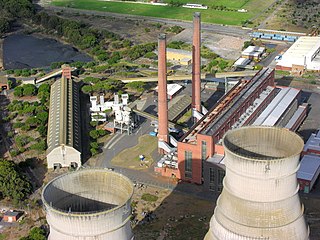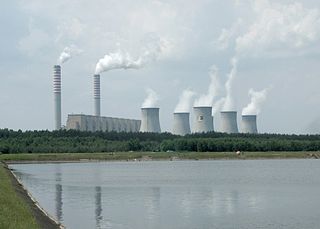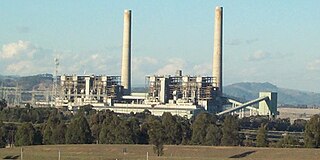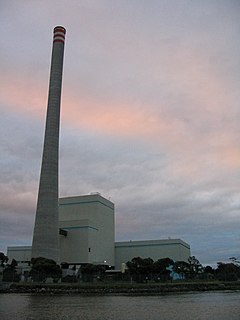
Electricity generation is the process of generating electric power from sources of primary energy. For utilities in the electric power industry, it is the stage prior to its delivery to end users or its storage.

A power station, also referred to as a power plant and sometimes generating station or generating plant, is an industrial facility for the generation of electric power. Power stations are generally connected to an electrical grid.

A combined cycle power plant is an assembly of heat engines that work in tandem from the same source of heat, converting it into mechanical energy. On land, when used to make electricity the most common type is called a combined cycle gas turbine (CCGT) plant. The same principle is also used for marine propulsion, where it is called a combined gas and steam (COGAS) plant. Combining two or more thermodynamic cycles improves overall efficiency, which reduces fuel costs.
Electric power systems consist of generation plants of different energy sources, transmission networks, and distribution lines. Each of these components can have environmental impacts at multiple stages of their development and use including in their construction, during the generation of electricity, and in their decommissioning and disposal. We can split these impacts into operational impacts and construction impacts. This page looks exclusively at the operational environmental impact of electricity generation. The page is organized by energy source and includes impacts such as water usage, emissions, local pollution, and wildlife displacement.

A fossil fuel power station is a thermal power station which burns a fossil fuel, such as coal or natural gas, to produce electricity. Fossil fuel power stations have machinery to convert the heat energy of combustion into mechanical energy, which then operates an electrical generator. The prime mover may be a steam turbine, a gas turbine or, in small plants, a reciprocating gas engine. All plants use the energy extracted from expanding gas, either steam or combustion gases. Although different energy conversion methods exist, all thermal power station conversion methods have efficiency limited by the Carnot efficiency and therefore produce waste heat.

The Yallourn Power Station is a complex of six brown coal–fuelled thermal power stations built progressively from the 1920s to the 1960s. Located in the Latrobe Valley of Victoria, Australia, the complex was situated beside the Latrobe River, with the company town of Yallourn located to the south west. Today only the 1,450 megawatts (1,940,000 hp) Yallourn W plant remains, the second largest power station in Victoria which supplies 22% of the state's electricity and 8% of the National Electricity Market needs. The adjacent open cut brown coal mine is the largest open cut coal mine in Australia, with reserves sufficient to meet the projected needs of the power station to 2032.

Liddell Power Station is a coal-powered thermal power station with four 500 megawatts (670,000 hp) GEC steam driven turbine alternators for a combined electrical capacity of 2,000 megawatts (2,700,000 hp).

Bayswater Power Station is a bituminous (black) coal-powered thermal power station with four 660 megawatts (890,000 hp) Tokyo Shibaura Electric (Japan) steam driven turbo alternators for a combined capacity of 2,640 megawatts (3,540,000 hp). Commissioned between 1985 and 1986, the station is located 16 kilometres (10 mi) from Muswellbrook, and 28 km (17 mi) from Singleton in the Hunter Region of New South Wales, Australia.
Mount Piper Power Station is a coal powered power station with two steam turbines with a combined generating capacity of 1,400 MW of electricity. It is located near Portland, in the Central West of New South Wales, Australia and owned by EnergyAustralia, a subsidiary of CLP Group.
Northern Power Station was located at Port Paterson in the Australian state of South Australia about 6 kilometres (3.7 mi) south of the city centre of Port Augusta. It was coal powered with two 260 MW steam turbines that generated a total of 520 MW of electricity. It was operated and maintained by Alinta Energy and was commissioned in 1985. Northern received coal by rail from the Leigh Creek Coal Mine, 280 km to the north. The plant ceased electricity production in May 2016 and decommissioned and demolished over the following few years.
Callide Power Station is located near Biloela, in Central Queensland, Australia. It is coal powered with eight steam turbines with a combined generation capacity of 1,720 MW of electricity. Callide A was commissioned in 1965, refurbished in 1998 and decommissioned in 2015/16. As of 2018, generation capacity was 1510 MW.

AGL Energy Ltd is an Australian listed public company involved in both the generation and retailing of electricity and gas for residential and commercial use.

The Kogan Creek Power Station is a 750 megawatt coal fired power station owned by CS Energy on the Darling Downs in Queensland. The $1.2 billion plant is situated at Brigalow, in the Surat Basin between Dalby and Chinchilla.

A coal-fired power station or coal power plant is a thermal power station which burns coal to generate electricity. Coal-fired power stations generate over a third of the world's electricity but cause hundreds of thousands of early deaths each year, mainly from air pollution.

A gas-fired power plant or gas-fired power station or natural gas power plant is a thermal power station which burns natural gas to generate electricity. Natural gas power stations generate a quarter of world electricity and a significant part of global greenhouse gas emissions and thus global warming. However they can provide seasonal dispatchable generation to balance variable renewable energy where hydropower or interconnectors are not available.

The Newport Power Station was a complex of power stations located on the west bank of the Yarra River, approximately 6 km south-west of Melbourne, Victoria, Australia, in the suburb of Newport. Newport A, B, and C were coal-fired plants which operated at the site between 1919 and the 1980s, and were claimed to be the largest power station in the southern hemisphere in 1953 with 42 boilers and 14 turbo-alternators producing 327 megawatts (439,000 hp).
Edwardsport Power Station is a 618 MW Integrated gasification combined cycle (IGCC) coal based power plant in Vigo Township, Knox County, near the town of Edwardsport, Indiana. The integrated gasification combined cycle power plant construction started in June 2008 by Duke Energy near the site of an older 160 MW coal-fired electrical power plant, which was decommissioned in 2010.

The Otahuhu power station site is located in Otara, Auckland, New Zealand, and holds two decommissioned plants; Otahuhu A and Otahuhu B. It also is the site for the proposed Otahuhu C power station. The station is owned Contact Energy.
Energy in Zimbabwe is a serious problem for the country. Extensive use of firewood leads to deforestation and the electricity production capacity is too low for the current level of consumption.














